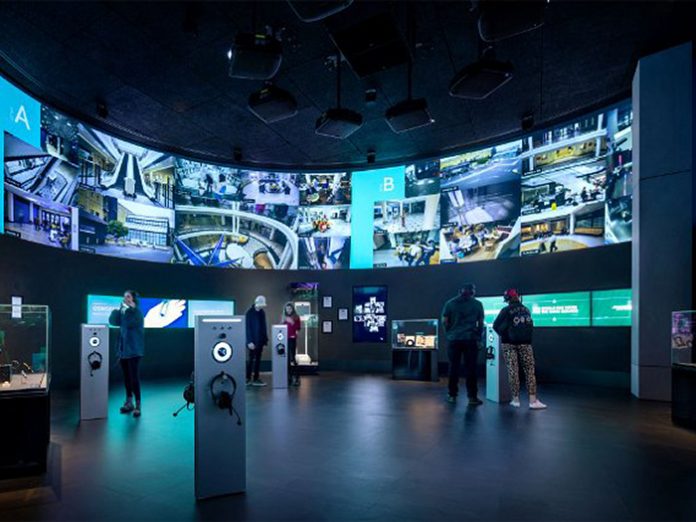SPYSCAPE, the new contemporary and interactive museum in Manhattan reveals how L-Acoustics’ L-ISA Immersive Hyperreal Sound technology makes the fantastic believable.
Deployed across two main rooms of the 60,000 square-foot Midtown venue, the museum’s L-ISA complement comprises five dozen L-Acoustics enclosures of various models into two multi-channel setups.
Working closely with SPYSCAPE Creative Director Ross Phillips, London-based Audio Director Nick Ryan and Technical Sound Designer/Immersive Mixing Engineer Davey Williamson was responsible for the sound design experience the museum would present to its audience.
Davey explained: ” We wanted to create a complex, captivating custom speaker deployment that enhanced the space and held almost limitless potential for immersive audio delivery to the audience, we designed the system from the ground up, working closely with Adjaye Associates, to ensure both of our concepts for audio and architecture complimented each other and worked in unison.”
The 19.1 L-ISA Hyperreal Immersive Sound configuration is comprised of three coaxial X12 speakers and three smaller 5XT on each side; left and right rear channels each use a pair of 5XT; the overhead “elevated” audio uses six 5XT speakers, and the system is anchored by a single SB18 subwoofer. Each of the 20 channels has its own amplifier channel through five LA4X amplified controllers. The systems were integrated by Swansea, Wales-based Atlas AV with local support from Certified Provider Firehouse Systems. The museum is located only a few blocks away from L-Acoustics’ NYC office, a convenient location for Application Engineer Jesse Stevens to provide additional on-site system support.
The film and music/sound design for the Briefing Lift was created by Territory Studios and synced via both Logic Pro X and Avid ProTools to gain the 300-plus discrete tracks that were required. A DiGiGrid MGB was to transport 64 channels of MADI as sources into a Pyramix system with a Merging Technologies HAPI audio interface.
Davey added: “We first created a mock-up of this at Nick Ryan’s studio, based in London’s Somerset House, a process that took place over a week. But being able to compose music, create sound design, and then mix, spatialise and use dynamic object movement through the L-ISA system in 3D was an immense advantage. We used Pyramix’s automation workflow with the L-ISA VST plug-in on 64 tracks to control the L-ISA Processor.
“We sent MIDI clock to both Pyramix and L-ISA controller from Logic so snapshots in the controller session were available and to keep Pyramix in sync. With so much of the visual content represented with sound design, we had a huge task to spatialize the environment with the audio soundtrack.”
L-ISA’s ability to let them precisely position each speaker and then apply object-based mixing over 300 channels of audio across this complex soundscape creates an astounding level of immersiveness.
Davey said: “We used a mixture of static placement and dynamic movement in our mixing palette, which came to great effect with the film’s immersive three-sided screen layout. Pyramix worked perfectly in tandem with the L-ISA controller, as the detailed yet efficient automation workflow was able to modify the locations of the sources in the L-ISA controller as required.”
SPYSCAPE’s second L-ISA room continues this effect on an even larger scale. The Surveillance Challenge 360-degree room is arguably the showpiece of the museum: a large, cylindrical space, around 50 feet diameter and 26 feet in height, and the gallery tells the story of surveillance.
The system comprises three rings of ten 5XT speakers each: one at floor level, one at the mid-wall height, and one at ceiling level. Eight more 5XT are deployed in a smaller ring on the ceiling pointed at visitor head height. Two SB18 subs placed in the centre of the ceiling facing down provide low-frequency coverage throughout the room. Ten LA4X amplified controllers power all elements across 40 discrete amplification channels.
Davey concluded: “Sherif El Barbari at L-ISA Labs, as well as the rest of the L-Acoustics team—including Guillaume, Florent, Cédric and Sylvain—were such a huge help in being able to pull this whole project off. The sound may be ‘undercover’ as far as the general public is aware, but it’s a mission-critical component to SPYSCAPE’s complete success.”





